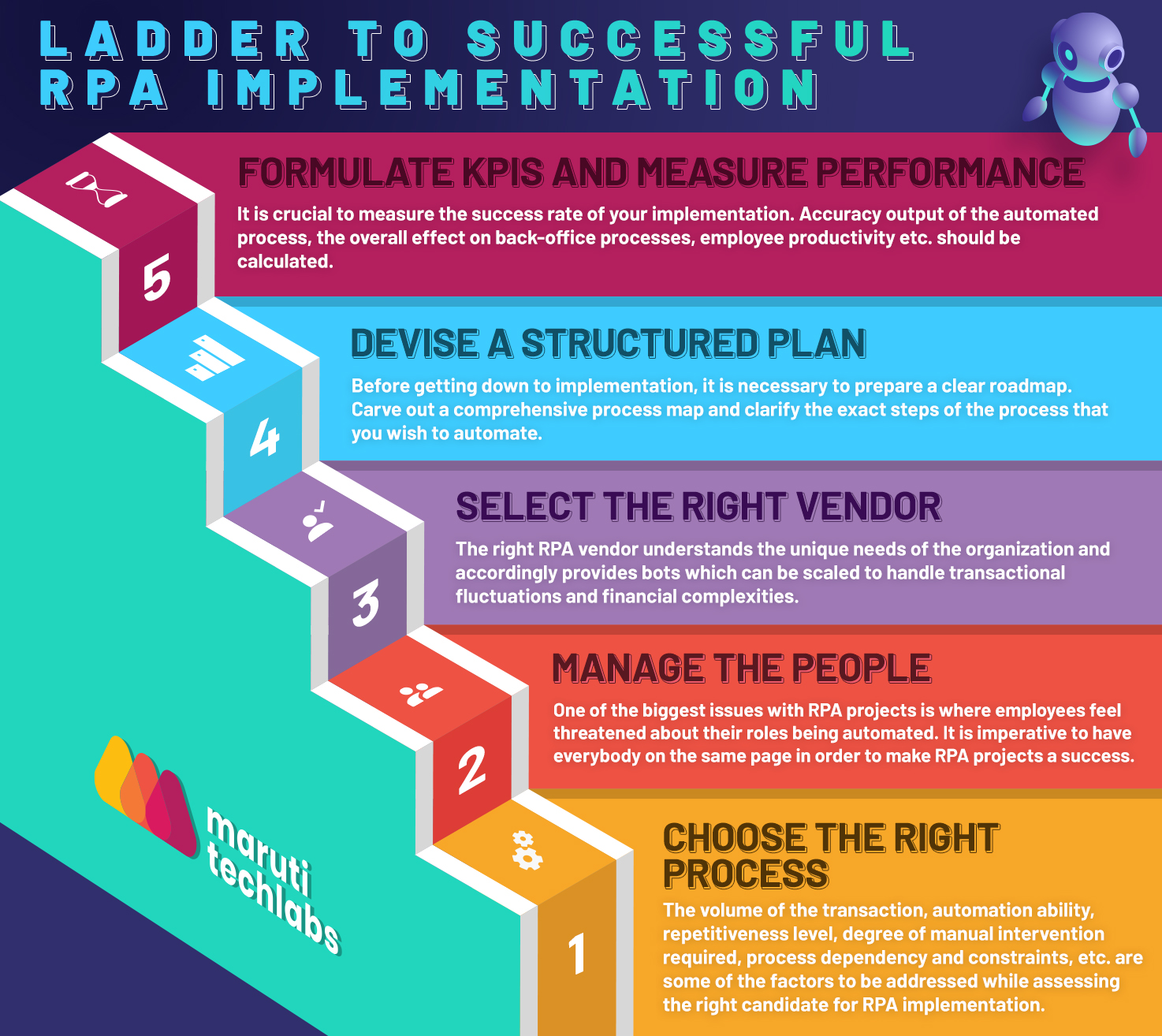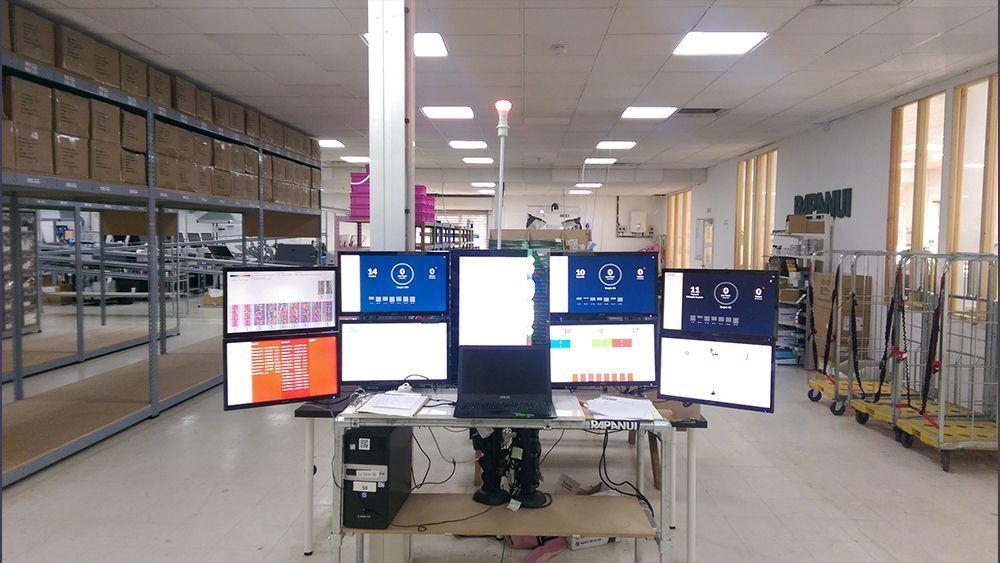Unlocking the Power of RPA: 5 Steps for Successful Implementation
The automation of business & operational processes works wonders towards enhancing your business potential. Requiring minimal upfront investment, it aims to provide quick organizational benefits without creating any sort of disruption in the underlying systems. Although there are a variety of traditional solutions which facilitate this approach, not all of them can perform as seamlessly as a successful RPA implementation.
According to Software Testing and Big Data Hadoop, almost 20% of work hours are spent on monotonous and repetitive computer-based tasks. This marks a considerable chunk of time which is lost on processes which are in dire need of automation.
Robotic Process Automation (RPA), in simple words, is a technology that employs computer software equipped with bots to perform tasks by emulating human actions. Primarily used for executing repetitive, predictable and high-volume activities, RPA works by capturing data, interpreting responses and communicating with other devices in an organized and systematic manner.
Despite the scalability and productivity which this technique offers, most businesses struggle with successful RPA implementation. This is mainly because they are either not able to accurately assess the specific processes which require automation or because they fail to get approval for RPA designing and integration. However, if you want the implementation of RPA to be an efficient affair, you would need to follow a stringent road map which balances the concerns of all stakeholders without compromising on the interests of any.
5 Step Process to a Successful RPA Implemention
Here’s a simple yet comprehensive 5 step guide to assist you in understanding the process of strategizing the implementation, development, and launch of an Robotic Process Automation within your organization or enterprise:
1. Picking The Process
When it comes to RPA implementation, selecting the right set of processes to automate, holds the key to success. To do this, you need to carry out a thorough assessment of all the operations, within and across various departments, so that you can determine which particular processes can prove to be good candidates for automation. Nonetheless, as most businesses operate in a complex and sensitive environment, conducting such an objective analysis becomes nothing short of a challenging task.
The answer lies in the development of a framework which aligns the primary intent of RPA with the organization’s strategic objectives. This framework should try to examine both the potential risks and the expected value, which can be derived from automation.
The following attributes can be considered and scored in a structured way to ascertain the suitability of a process for automation:
- The total volume of transactions that can be performed without human intervention.
- The amount of labor or resources required to execute repetitive tasks at regular intervals.
- The ability of the components and sub-components of a process to be digitalized.
- The capacity of a process to deliver an excellent customer experience without any manual errors.
- The possible constraints which might obstruct the harvesting of automation benefits.
- The capability of the rules that govern a process, to be mechanically defined and programmed.
- The sensitivity and relevance of a process in the overall organizational workflow.
Apart from the aforementioned, factors like probable impact, compliance requirements, cost-effectiveness, technical complexity, and data privacy might also come in handy for identifying the processes, which can yield the most significant rewards after a successful RPA implementation.
2. Managing The People
Even though it deals with automation, implementation of RPA is basically all about managing the people. The organization right from the top rung to the grassroots must be taken into confidence. To begin with, a compelling case has to be built for the company’s leadership to take notice. They must be informed about the need for automation, its essentiality and how it is likely to influence the return on investment (ROI).
Once this is done, the next step is to convince the employees. A lack of appropriate understanding on their part can lead to the fear that robotic process automation implementation might take their jobs away. The unease that accompanies automation is genuine, and that is why it needs to be adequately addressed by having open and honest discussions.
Talk to the staff about what automation will bring. RPA would only work as a process of filtering out redundancy and improving productivity. It would never be allowed to replace their jobs.
For still inspiring greater confidence, build a cross-functional team from amongst the employees to oversee successful RPA implementation. Empower the team to deal with operational challenges and grievance redressal while facilitating the proliferation of RPA technologies. This would also include coordinating with departments like IT & HR to make sure that the incorporation and configuration of RPA is absolute and complete.
As the business gets ready to embrace the new, it is now time to focus your attention on the selection of a competent RPA vendor.
3. Selecting The Vendor
All organizations have unique needs. To fulfill them, they require RPA vendors who understand these needs and offer customized solutions which can only happen when the organization has conducted a detailed evaluation to determine the precise tools that it would require for a successful RPA implementation.
Here is a list of parameters that you must bear in mind while selecting a vendor for RPA so that pitfalls, if any, can be avoided:
- The likely cost and time that they would require to deploy software bots.
- Their ability to provide bots which can be scaled to handle transactional fluctuations and financial complexities.
- Provisions made for encrypting stored data and ensuring its privacy and confidentiality.
- Positioning systems to alert the organization in case there is a process error or a data breach.
- The presence of an audit trail feature which records every action taken by the bot, thus, enabling performance monitoring.
- The vendor supplied RPA tool should also be non-intrusive and well-equipped to adapt with changing technologies.
Additionally, the technical prowess of the vendor should be verified along with their organizational credentials. The commitment of a vendor to the RPA domain can be substantiated by their previous associations, governance history, and development experience. Ultimately, it is only the capability of the vendor to combat automation issues, that can help you implement Robotic Process Automation skillfully.
4. Implementing The Idea
Before getting down to the actual execution, it is imperative to devise a meticulous and structured implementation approach which will define the contours of your overall strategy. At the initial stage, a team that has been tasked with the implementation of RPA, would identify the requisites and provide guiding principles that will help individual business units drive automation.
Once the framework has been designed, an implementation partner would be chosen which can either be an RPA vendor or an in-house crew. Irrespective of who you choose, make sure that they have the necessary functional know-how, the domain expertise and the technical competence to undertake successful RPA implementation.
The next step is to develop an appropriate solution. Carve out a comprehensive process map and mark the specific parts, which you plan to automate. Document this map, clarify the exact role that you expect RPA bots to play and program them accordingly. Throughout this time, ascertain that the various departments and personnel involved are operating in sync. Just as the programming is complete, run a few tests.
The infrastructure, software and other systemic variations can sometimes lead to the cropping up of minor issues. Therefore, iterate the processes repeatedly and resolve any unexpected hindrances that might arise. After you have considered all the major scenarios and crafted a fallback plan, get ready to run the pilot.
While the pilot is in operation, charge the team by randomly selecting bot outputs and reviewing them. Evaluate the results which have been obtained during this test run and use them to rectify glitches, if any. If the bots are working correctly, configure them to handle changes. This implies that a mechanism should be put in place, which equips them to continue functioning, even if the processes change. As this settles, inform all the stakeholders of their roles and responsibilities concerning robotic process automation implementation. Finally, double-check your contingency plan and go live!
5. Measuring The Performance
Last but not the least, formulate key performance indicators (KPIs) on the basis of which you can find out the success rate of your RPA implementation.
Although these metrics can vary from one organization to another, they generally tend to include:
- Measuring how the deployment of RPA has affected the back-office processes.
- Finding out if the productivity of employees has increased by comparing the time in which RPA finishes a task with the time in which human workers perform the same function.
- Calculating the accuracy of the output, which ideally, should have increased to a hundred percent.
- Analyzing the compliance reports of RPA, i.e., the efficiency with which the bots are adhering to rules and regulations.
A candid assessment would highlight any possible discrepancies and give you sufficient time to rectify them. After the completion of the incubation period, more such evaluations based on these yardsticks should be carried out, so that any gaps left in the successful RPA implementation plan can be timely identified and corrected.

Looking Ahead
For proper implementation of Robotic Process Automation, a business needs to blend diligence with skill. Considering the massive importance and benefits of RPA solutions in reducing efforts, improving customer service and increasing profits, it becomes pivotal to ensure that every step is duly scrutinized, vetted and backed.
When it comes to a successful RPA implementation, it is only more ROI positive and advantageous when it is considered as a platform and not some separate tool. With a bigger and more encompassing scope for automation, enterprises are guaranteed to see a more profound impact. After all, automation allows businesses to expand their digital footprint and be a part of the digital transformation which harbors the capacity to change the future significantly!
At Maruti Techlabs, We help you identify the right use cases and implementation strategy to increase ROI. Leverage the benefits of RPA with our deep domain expertise. Write to us at hello@marutitech.com or request a FREE 30 min consultation call with our RPA consultants and engineers.





















